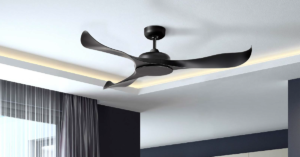When buying a ceiling fan, you’ve likely seen AC and DC motors mentioned. But many people are unsure of the difference. As ceiling fan technology has advanced, DC motor ceiling fans are becoming more and more popular. And there are good reasons for this. Today we are going to discuss the difference between AC and DC motors and why you should buy a fan with a DC motor.

What are AC and DC Motors, and What is the Difference?
When brands and appliances refer to AC or DC, they refer to how the current flows within a circuit to generate power. AC stands for Alternating Current. This means that the current flows in alternating directions, back and forth. DC, on the other hand, stands for Direct Current. And, as the name suggests, it refers to a current that flows in a single direction. So what does this mean for your ceiling fan?
A ceiling fan needs a force to be generated that is strong enough to rotate the motor. This, in turn, pushes the fan blades, allowing the fan to cool your space. An AC ceiling fan generates this force directly from the power source. A DC motor ceiling fan connects the power source to a transformer. This converts the AC power to DC and then uses magnets to create the force needed to rotate the motor.
Both AC and DC ceiling fan motors require the same force to rotate the motor’s rotor and push the blades. The difference between AC and DC, however, is the amount of energy required directly from the power source.

Why You Should Buy a Ceiling Fan with a DC Motor
When looking at the differences between AC and DC motors, there are some significant advantages when choosing a DC fan.
1: Lower Energy Consumption
DC ceiling fan motors don’t have to generate as much force as AC motors to turn the fan blades. In fact, DC fans use up to 70% less energy than AC fans. This means they produce the same output compared to a similar capacity AC fan, for significantly less energy. This will obviously save you money in the long run.
2: DC Fan Motors are Quieter
In general, DC fans are much quieter than AC ceiling fans. While ceiling fan technology has improved significantly over the years, AC fans still can’t quite escape that signature “hum” we associate with fans. This hum is usually caused by an electrical buzz created by the motor working to generate the force needed to push the fan blades. Comparatively, DC fans operate significantly quieter because the force needed to move the fan blades is so much less. This is due to the fact that blade movement is generated by magnets, which are obviously quieter than an AC motor. As a result, DC ceiling fans are generally the preferred fan for bedrooms and other intimate spaces.
3: Better Design
DC motors are compact and light. This means there is a greater capacity for slimmer ceiling fan designs and lighter weight. This has allowed designers to make significant advances in general ceiling fan design. This transforms your ceiling fan from a simple household appliance to one that makes a true design statement in your space. DC fans come in a range of colours, finishes, and materials, allowing you to match your fan to any décor.
4: Improved Features
In general, DC ceiling fans are generally faster to respond to remote controls. They also have more speed options and even have a reverse function on the remote. This allows you to easily set your fan to summer or winter mode, to enhance the comfort of your home. As a result, DC fans put convenience and control directly into the hands of their users. And by allowing greater control over speed, you can also lengthen the life of your ceiling fan.

There are many advantages to choosing a fan with a DC motor. However, there are benefits to using an AC fan as well. Click here to read more about AC ceiling fans.
Are you looking for the perfect ceiling fan for your home? Explore the Martec range of DC ceiling fans today, or contact the team to help find the perfect fan for your space!